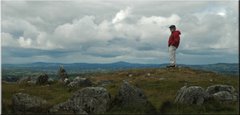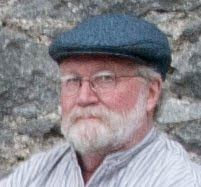Please click on the images to see larger, more detailed versions.

The Carina Nebula
(Except where otherwise noted, all illustrations in this post are modified from a single NASA image.)
NASA released this magnificent mosaic of the Carina Nebula and its environs on April 24th of this year, the 17th anniversary of the launch of the Hubble Space Telescope. It comprises 48 monochrome images from the HST’s “Advanced Camera for Surveys” (a relatively wide-angle instrument) and color information from the 4-meter Victor M. Blanco Telescope of the Cerro Tololo Interamerican Observatory in the Chilean Andes.
The image shows a complex region of star formation and interstellar gas approximately 7,500 light years away from us, and spans about 50 light years in its longer dimension.
It is a spectacular picture. It is also available for free in a wide variety of different resolutions and file sizes – including ones big enough to use to print out wall-mural sized reproductions – at the Hubblesite.
ZOOM!
The image I downloaded for my personal and classroom use is the 7.32 meg high resolution one, available here. It’s plenty big for all kinds of fun exploration, and bears up well under multiple zooming-ins. The images in this section are simply cropped portions of that 7.32 meg original.
You can get lost poking around in the image. Here are some of my favorite parts (this evening, at least):
 “Pillars”
“Pillars”
The brown streamers of gas and dust probably are being pushed away from nests of star formation near their heads by an intense outflow of radiation and, possibly, stellar wind from Eta Carinae, a massive, unstable star to their upper-left in this view. The streamers, or “pillars” as they’re called, are several light years long. I call the one at the right…

… the “Spaniel Nebula,” because it bears a certain resemblance to my little dog, Emma, in profile.
Eta Carinae itself…

… is at the heart of the bright cloud in the center of this zoom. It is a famous star to astrophysicists, an irregular variable, hyperluminous, and probably just about as massive as a star can be – in theory, about a hundred times the mass of our Sun. The two bright lobes of gas near the center of this zoom are themselves centered on the star Eta Carinae, and were probably ejected during a long “outburst” of luminance more than a hundred years ago. The history of Eta Carinae’s brightness is an interesting one, nicely recounted in its entry in the venerable (and mammoth) SEDS astronomy site.
Eta Carinae is so massive that it can't be very old, relatively speaking, perhaps only a few million years. (Our Sun, for contrast, has existed for approximately five thousand million years.) The Carina Nebula area is in a spiral arm of the Milky Way just a little closer to the center of the Galaxy than we are, and its environs probably take about 200 million years to orbit around the center of the Galaxy once – so the whole region shown in the Hubble anniversary picture hasn’t moved very far, relatively speaking, since Eta Carinae formed.
It is rife with stellar youngsters and cocoons, including…
 Trumpler 14
Trumpler 14
… the star cluster Trumpler 14 which, in turn, includes an intensely black clump of dusty material, much less than a light year across. This “Bok Globule” (at upper center of this zoom frame) probably contains a forming star or stars – nature shrouds the latter stages of stars’ formation in a shroud of modesty.
Personal aside: I feel a little bit of a connection with Trumpler 14 and its Bok Globule in what I guess is a bit of an old-mannish way. “Trumpler” was Robert Trumpler, a Swiss astronomer who was a pioneer researcher on the gas and dust of the Milky Way in the middle part of the last century. He and his son-in-law, Harold Weaver, wrote one of the most notable reference works in mid-20th century astrophysics, Statistical Astronomy – and I was priveleged to take courses from Dr. Weaver in graduate school. Bok Globules are named after Bart Bok, another mid-20th century astronomer, who (with his wife Priscilla) took time from his research to write inspirational books about astronomy for young readers. Their The Milky Way is one of two books that I think set me on the road to becoming an astronomer – and I’m surely not alone in that.
 Bart Bok (image: National Academy of Sciences)
Bart Bok (image: National Academy of Sciences)
Does it really …?
A common and understandable question I get from students (and others) when I show them the Hubble anniversary picture of the Carina Nebula is, “Does it really look like that?” My answer is always, “what do you mean by ‘really’?”
If one limits oneself to the weak eyes of humans, the answer is “no, that’s not what it looks like at all.” Here are a few steps to what it would look like with human eyes:
Step 1:
Without a telescope, the scene would be smaller (but not a whole lot.) If you print out the picture at the top of this blog entry so that it’s ten inches across and then view that printout from a distance of about fifty yards, that would be about right.
Step 2:
The cones (color-sensing cells) in the retinas of our eyes are not sensitive enough to be triggered by the weak light of the nebula’s glow, so step 2 is to remove all color (rough image adjustments done using L-View Pro):

Step 3:
Our eyes evolved to see in a very bright environment. The gas in the Carina Nebula is faint, so we’d probably really see something like this:

So, no, the anniversary image is not what the Carina Nebula region would look like to beings with eyes like ours -- and hallelujah for that. The primary purpose of most astronomical telescopes is to provide the brightest possible images of faint things, so, in a way, the primary purpose of an astronomical telescope is to show us what things don’t look like! In addition, the colors of the anniversary image are false (but informative) as well. Images were taken at the Cerro Tololo Interamerican Observatory in Chile of the region through filters that isolated the light of tenuous oxygen, hydrogen, and sulfur gas in the nebula, which were then coded into the anniversary image as blue, green, and red, respectively, for an RGB computer-friendly image. Not at all what we’d “see,” of course, but not made up out of whole cloth, either, and very useful. Thanks to modern imaging technology, we can all be Geordi LaForge in our celestial viewing.
So, what would it really look like to be in the midst of a spiral arm of a giant galaxy, surrounded by star clusters and nebulae? That’s easy to find out: go outside and look up, because that’s where we live. The view from our planet – if we take care to go to a very dark, clear place and allow our eyes the time to adapt to the dark – is as staggering as anything in a George Lucas Star Wars film.
"No telescope. No binoculars."
I was priveleged to talk to Bart Bok several times in the late 1960’s and early ‘70’s (he passed away in 1983), and one conversation I remember particularly vividly involved his description of the Milky Way as seen from the Southern Hemisphere, from which the constellation Carina can be seen, along with its particularly rich area of the Milky Way. “No telescope,” he said, “no binoculars” are needed to be awed to the core by the majesty of the galaxy as its magnificent arch spans from horizon to horizon in South Africa or Australia, especially in April or May, when the center of the Galaxy, Sagittarius, Scorpius, and Carina ride high in the night sky.
“If we could have seen the center of the Milky Way from the Northern Hemisphere,” he said, “there never would have been any doubt that we live in a spiral galay. It would have been obvious. No telescopes. No binoculars. No debate.”
==============================================
Some reference links:
Downloading the image:
http://hubblesite.org/newscenter/archive/releases/2007/16/image/a/
“Color” info:
http://heritage.stsci.edu/2007/16/original.html
A very good (as of this evening) Wikipedia entry on the image:
http://en.wikipedia.org/wiki/Eta_Carinae_Nebula
Eta Carinae (the star) general information page from the University of Minnesota, including great images:
http://etacar.umn.edu/etainfo/images/
Eta Carinae (the star) at SEDS:
http://etacar.umn.edu/etainfo/images/
 If I lived on the planet Mercury, I would be about 250 years old. If I lived on Mars, I would be coming up on my 32nd birthday. But I live on Earth, where I just turned 60, which seems to be a significant thing, if I let it.
If I lived on the planet Mercury, I would be about 250 years old. If I lived on Mars, I would be coming up on my 32nd birthday. But I live on Earth, where I just turned 60, which seems to be a significant thing, if I let it. Ralph and Marie Inman's House, Washington Street, Oxford, New York
Ralph and Marie Inman's House, Washington Street, Oxford, New York Little baseball field near Gibson School in Norwich
Little baseball field near Gibson School in Norwich Veterans' Park, Norwich
Veterans' Park, Norwich Houses near the old railyards, Norwich
Houses near the old railyards, Norwich North Norwich from the East
North Norwich from the East Pastorale #2: Meadow Detail
Pastorale #2: Meadow Detail The Red Mill Bridge
The Red Mill Bridge






























